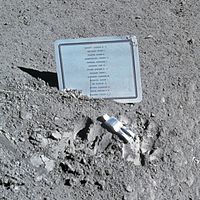Tourism on the Moon

Tourism on the Moon, also known as lunar tourism, refers to space tourism on or around the Moon, the natural satellite of planet Earth. Some space tourism startup companies are planning to offer tourism on the Moon in the near future. Some individual companies estimate or claim that tourism on the Moon will be a reality sometime between 2020 to 2043.[1][2]
Companies

Space tourism companies which have announced they are pursuing lunar tourism include:
Types

- Circumlunar: In this type of lunar tourism, the spaceship doesn't land on the Moon's surface; rather, it revolves around the Moon using a circumlunar trajectory and returns to Earth. According to Space Adventures, tourists will come within 100km of the lunar surface.[5]
- Lunar Landing: In this type of tourism, tourists will land on the surface of the Moon.
Cost
Some of the space tourism start-up companies have declared their cost for each tourist for a tour to the Moon.
- Circumlunar tourism: Excalibur Almaz and Space Adventures are charging $150 million per seat, a price that includes months of ground-based training, although this is only a fly-by mission, and will not land on the Moon.[4]
- Lunar landing: The Golden Spike Company is charging $750 million per seat for future lunar landing tourism.[6][3]
Possible attractions
Two natural attractions would be available by circumlunar flight or lunar orbit, without landing:
- View of the far side of the Moon[5]
- View of the Earth rising and setting against the lunar horizon[5]
Other possible attractions include:
- Lunar craters
- Moon Impact Probe of India[7][failed verification]
- Chinese Lunar Rover[citation needed]
- Soviet Lunar Rovers[citation needed]
Commemorations on the Moon
There are remnants of several missions left on the Moon:
- Apollo 11, 12, 14, 15, 16, and 17 each left a commemorative plaque and US flag at their landing sites. The plaque left on Apollo 17 contains a special message commemorating the last human lunar exploration of the twentieth century.
- Fallen Astronaut is an 8.5-centimeter (3.3 in) aluminium sculpture, accompanied by a plaque listing American and Soviet lives lost in the advancement of space exploration, left near the Apollo 15 landing site at Hadley Rille.[8]
- Pennants of the Soviet Union on the Luna 2 unmanned spacecraft, which impacted the Moon in September 1959[9][failed verification]
Protection of lunar landmarks
The site of the first human landing on an extraterrestrial body, Tranquility Base, has been determined to have cultural and historic significance by the U.S. states of California and New Mexico, which have listed it on their heritage registers, since their laws require only that listed sites have some association with the state. Despite the location of Mission Control in Houston, Texas has not granted similar status to the site, as its historic preservation laws limit such designations to properties located within the state.[10] The U.S. National Park Service has declined to grant it National Historic Landmark status, because the Outer Space Treaty prohibits any nation from claiming sovereignty over any extraterrestrial body. It has not been proposed as a World Heritage Site since the United Nations Educational, Scientific and Cultural Organization (UNESCO), which oversees that program, limits nations to submitting sites within their own borders.[10]
Interest in according historical lunar landing sites some formal protection grew in the early 21st century with the announcement of the Google Lunar X Prize for private corporations to successfully build spacecraft and reach the Moon; a $1 million bonus was offered for any competitor that visited a historic site on the Moon. One team, led by Astrobotic Technology, announced it would attempt to land a craft at Tranquility Base. Although it canceled those plans, the ensuing controversy led NASA to request that any other missions to the Moon, private or governmental, human or robotic, keep a distance of at least 75 meters (246 ft) from the site.[10]
Gallery
-
Earthrise over the lunar horizon, as seen from orbit on Apollo 10
-
Far side of the Moon photographed by Apollo 16 crew
-
Fallen Astronaut memorial left by Apollo 15 crew
-
Buzz Aldrin's boot print on the lunar surface
-
Chinese Yutu rover on the Moon, photographed by Chang'e 3 lander.
See also
References
- ^ a b Gilbert, Dave (2013-12-09). "Could Virgin Galactic launch tourist trips to the Moon by 2043? - CNN.com". Edition.cnn.com. Retrieved 2015-08-21.
- ^ "Moon Tourism by 2020, Entrepreneurs Predict". Space.com. 2010-02-03. Retrieved 2015-08-21.
- ^ a b Lecher, Colin (2012-12-06). "Space-Tourism Company Is Selling Trips To The Moon For $750 Million Each | Popular Science". Popsci.com. Retrieved 2015-08-21.
- ^ a b c "Fly me to the moon". The Economist. 2012-06-30. Retrieved 2015-08-21.
- ^ a b c "Space tourism firm offers flight around the moon on Soyuz crafts — RT News". Rt.com. Retrieved 2015-08-21.
- ^ "Space-tourism company to offer two seats to the moon - Americas - World". The Independent. 2012-12-07. Retrieved 2015-08-21.
- ^ "MIP detected water on Moon way back in June: ISRO Chairman". The Hindu. 2009-09-25. Retrieved 2015-08-21.
- ^ "Sculpture, Fallen Astronaut". Smithsonian National Air and Space Museum. Retrieved 17 July 2014.
- ^ Soviet Craft - Luna (1958-1976)
- ^ a b c Chang, Kenneth (January 10, 2012). "To Preserve History on the Moon, Visitors Are Asked to Tread Lightly". The New York Times. Retrieved January 11, 2012.







